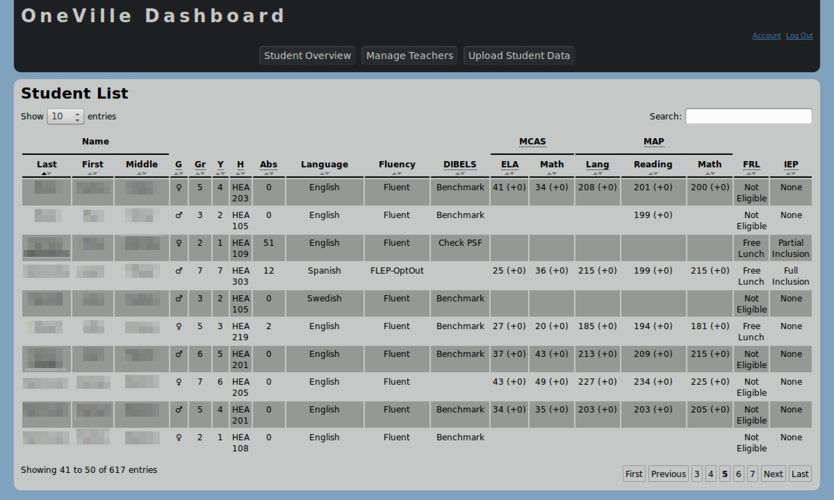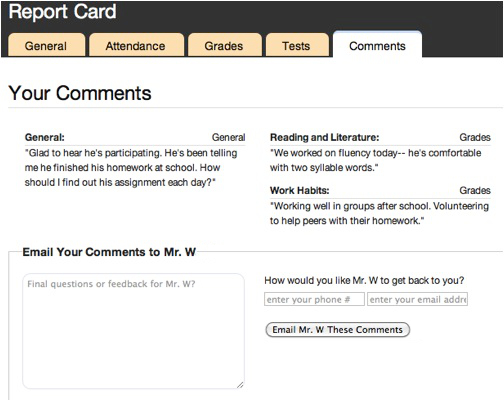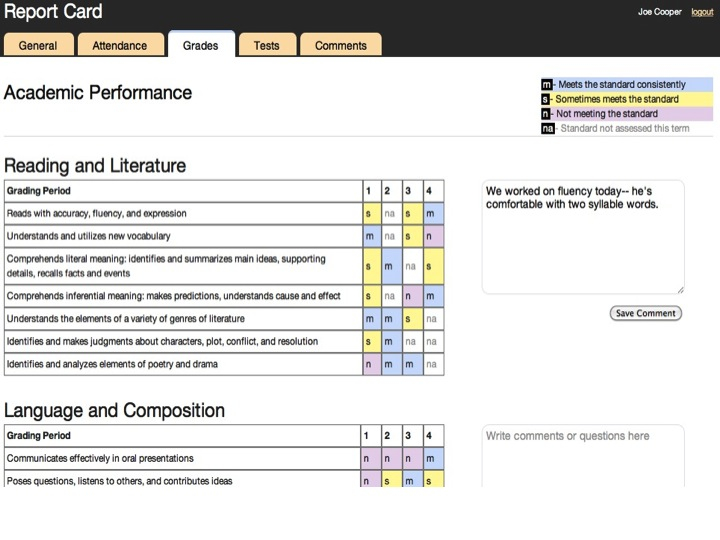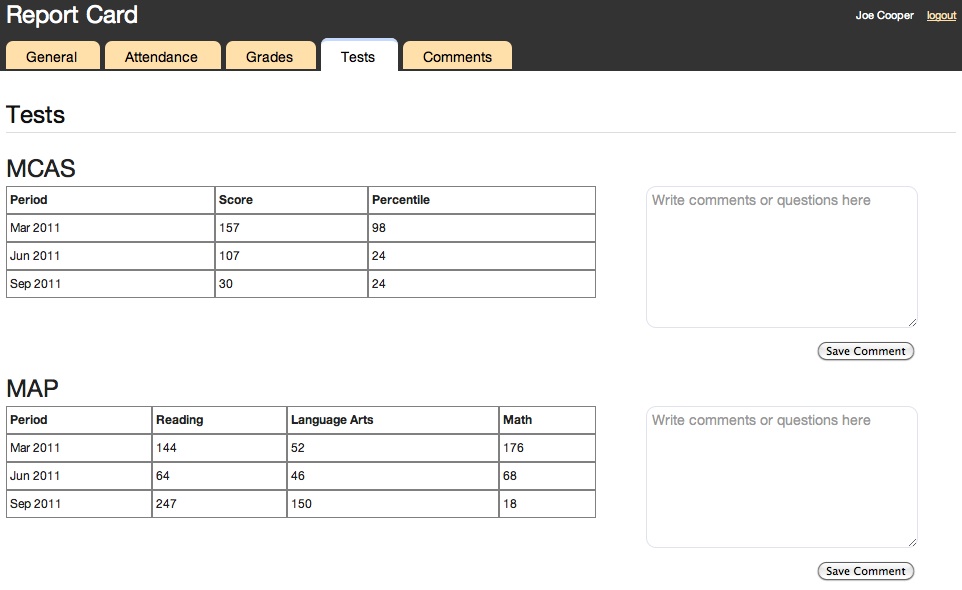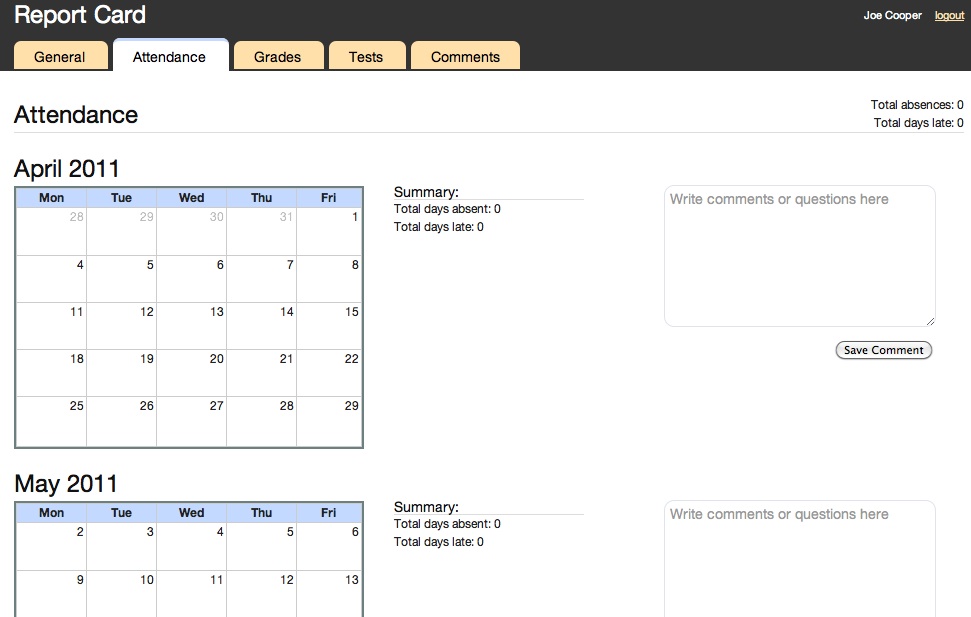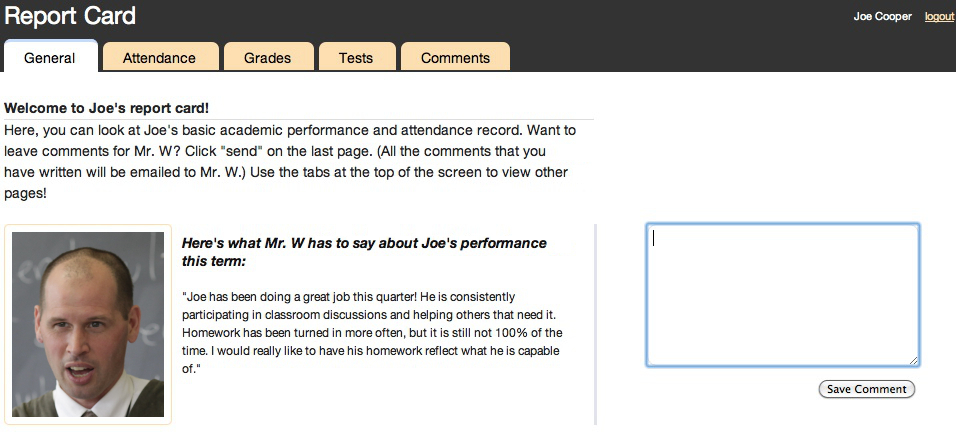Overview and key findings: Data dashboards
From Oneville Wiki
Written by Mica Pollock and Jedd Cohen for the dashboard project, with initial dashboard development by Somerville technologist Seth Woodworth and next development for piloting by David Lord of San Diego
Click here for the Summary on this project; click here for the Expanded story on this project.
Communication we hoped to improve
What aspect of existing communication did we try to improve, so that more people in Somerville could collaborate in young people's success? How’d it go?
- (Who was involved in the project and how was time together spent? What did the project accomplish?)
In an era when you can log on to any computer and get quick updates from friends, shouldn't the people who need to see basic data in order to serve young people be able to see it immediately?
Unfortunately, access to the data tools needed to provide this info (and, knowledge on how to use those tools) varies widely among districts. Some districts and schools that can afford it are investing in sophisticated data systems made by private companies; sometimes those companies fold, leaving districts in the lurch again. Resource-strapped districts and schools often can’t afford to buy such tools. And when districts do have online data display tools, educators or parents often aren't trained on how to use them -- and most typically haven't participated in maximizing those tools' design. So, even in districts that have created expensive data display systems, often the problem is getting people to actually use the system to support students better. So, we wanted to try to design tools to community specifications.
In Somerville, teachers and administrators said they couldn’t easily view or sort patterns in student data because that data was buried in different “fields” in the student information system (SIS), which Somerville couldn’t afford to replace or fundamentally upgrade.
We - local academic researchers and a teacher co-researcher (Josh), and several local technologists - worked with one classroom's families, related afterschool providers, and two principals (with the ongoing advice of central administration in the Somerville School District), to try to meet the need for a user-friendly, affordable way to view and examine lots of student data in one place. The result of our work is a suite of three “data dashboards," open source web applications designed to let family, teachers, principal, and afterschool providers quickly view and sort data they need to see. We created an “admin view” for principals, which shows Student Information System data on all students in the school; a “teacher view,” which shows a teacher such data on the students in his or her class; and an “individual view,” designed to link teachers, afterschool providers, and families in communication about the details of an individual student’s data profile.
In the dashboard project, we thought a lot about who needs to see which data on children. The quantitative measures or summary data about young people kept in a typical "Student Information System" (e.g., students' absences; their credits; a report card) never show "the whole child": eportfolios can help with that. But such basic measures still provide information crucial to the process of tracking student progress. And they do tend to predict things like graduating or “dropping out.”
We undertook a collaborative design process that asked different district and school administrators, parents, and afterschool providers to look at the developing tools and comment on that very question -- which data available in Somerville's Student Information System was most important to view on demand? We held regular meetings with teacher and co-designer Josh, did repeated interviews with principals and service providers, and met with parents and service providers in evening review meetings. Somerville technologist Seth Woodworth, with Somerville technologist Evan Burchard (now of San Francisco), created the initial core of three views. Seth was working on the dashboard while also helping to project manage on other efforts, and after the initial technological development went slower than we all hoped and budgeted for, delaying a fall pilot, David Lord, a fabulous and generous young developer in San Diego, developed the views to near professional-level completion for us for free. At the end of this page, you'll find the code for all three views. This code, and so, the dashboard tools themselves, are freely available for anyone to complete and adapt.
While just implementing a store-bought tool could have been faster, -- and while the future of open source, free dashboard design for schools likely lies in large, experienced tech development groups tackling such projects for pay -- we felt that it was crucial to collaborate with the Somerville community to design the tools. In that process, some issues about data display became clear to us:
A gap in student data equals a gap in service.
Principals Vadhera and DeFalco, teacher Josh, and various students we talked to in our other pilots, all mentioned instances where a student “fell through the cracks” because of a piece of missing data. For example, some stakeholders told stories of a student who received an unexpectedly poor grade, with the parent, the homeroom teacher, or the administrator surprised by the news. Administrators also described how seeing patterns faster could support timely interventions. For example, Principal Vadhera talked about needing to quickly sort data by "students with IEPs," to ensure these students had MCAS accommodations on testing day.
One-Stop Shopping: It seems crucial to be able to see different kinds of student data at the same time, in a single display -- and, to be able to sort that data to check for patterns.
To clarify: Somerville, like a typical district, already has a “student information system” - a database that stores or “warehouses” student information. The issue is that such data have been hard for people to view quickly all in one place, or sort quickly for patterns that are displayed in one view.
We've been learning that many schools as well as afterschool programs do not have easy tools for quickly displaying (or sorting) basic information for multiple partners to view at once, all in one place and in simple form. In Somerville, while the data on these "dashboards" all exist in Somerville's student info system, lots of people still talked about the need to improve display of that data for parents and students, teachers, afterschool providers, and administrators. To see patterns using the existing Student Information System, administrators often sent many data analysis requests to a central office (filled with great staff!) and the staff would send patterns back to them. Or, teachers had to create their own Excel spreadsheets or printouts and analyze them by hand. Administrators also told us of time wasted in meetings as staff flipped through multiple folders or drawers to find data. Staff said they wasted time preparing for such meetings by trying to analyze patterns by hand. Finally, parents could access the student information system with a password, but many parents said they didn't know about this feature, and some had a hard time understanding the way the system displayed data (which was also only in English). So, we designed the "dashboards" to sit on top of the student information system and "pull" data out for easy viewing (and for two of the views, sorting), all in one place. Our goal was to translate the interface on the "individual view," for parents.
The dashboards are also designed to be automatically updated, with the last iteration anticipating updates through routine emails of data sets from the district's IT staff. For full adoption, a small amount of programming could afford further automatic upload.
Open source data tools could save schools across the country significant costs, IF design goes fast enough, IF community users are ready to use the tools, and IF tech support for open source tools remains available locally.
Others had offered to make Somerville data-viewing tools for hundreds of thousands of dollars; the tools would then require tens of thousands of dollars for annual upkeep. We figured that with our Ford grant, we could work with a local technologist to develop an open source tool to educators' and parents' specifications, free to the district. Also, a "free" tool meant a sharable tool. Any next district or developer could then have the software for their own use.
It's true that open source development produces a free tool, meaning that districts wouldn't have to buy the product itself or renew the license to use it. But those using open source tools still have to pay for services, for upkeep and troubleshooting the tool. Still, we reasoned, this can be a fraction of the cost of storebought tools. Our local technologist Seth put it this way: “Take the quarterly profit of a company like Blackboard INC (Quarter 1, 2010) and break it down into services and license fees. In just one quarter, Blackboard made only $7.3 million in services [tech support], but made $93.7 million dollars in 'product revenues' (licenses to run their software). In the K-12 context, a freely available and documented open source competitor to store-bought communication tools would free up a lot of money back to US schools.” Districts that pay lots of money for store-bought, "off the shelf" dashboard tools also often can find them unused by the community -- or, companies often go out of business, leaving districts searching for tech support or next products. For all these reasons, we wanted to try to build something "free" to community specifications instead.
In all this, we've encountered the core problem with designing and creating tools from scratch, to community specifications and on a fixed budget: relying on part-time individual technologists rather than large companies. While our local technologist worked to produce tools to community specifications, he went far slower than budgeted for, leaving us unable to pilot the dashboard. We were fortunate to find another technologist, David Lord, based in San Diego, to bring the admin and teacher dashboard views to near completion for free.
We note that professional-level local technologists on larger budgets might provide more immediately ready open source infrastructure for schools and districts. So can technologists with products closer to final development. Our other "from scratch" tool experience went better: after the same local young technologist struggled to complete our prototype Parent Connector Network hotline, a professional-level hotline was finally prototyped rapidly by Leo Burd, a new colleague at MIT's Center for Civic Media who specialized in such open source (VOIPDrupal) tools for voice-messaging and was inspired enough by the Parent Connector project that he did it for free. See the Parent Connector Network project!
The administrator view
We based the administrator and teacher views on an Excel spreadsheet model created by Healey dad Greg Nadeau, which staff were trying to update annually by hand in 2009. In partnership with Principals Jason DeFalco and Purnima Vahdera and teacher Josh Wairi during the 2010-2011 school year, we updated fields on these views to teachers' and administrators' specifications. Most important, we made all data fields visible on one screen, so there is no need to click through multiple windows to view the desired data, as users do to see data in the district's Student Information System. Viewers can also sort up to three columns at a time simply by clicking at the top of each while holding down the shift key. Whereas the admin view lists all students in the school, the teacher view presents similar information for a single class of students. Here is the admin view, with fictional, blurred data to maintain confidentiality:
The individual view
Our individual view (below) was designed to be used by educators, parents, and afterschool providers; it complements the "admin" and "teacher views" with additional student data that Healey parents, students, afterschool providers, and teachers named as being especially relevant to see.
Importantly to the OneVille Project, this "individual view" also was designed to give parents and afterschool provider viewers the chance to comment ON the data and send these comments to the teacher's email inbox, sparking an exchange that could continue over email or in person. The current Student Information System only allowed viewers to view data, not comment on it. So, unless the people in a student's life were sitting together looking at the SIS, data display also couldn't easily launch a conversation between those people.
Our screens also have a minimum of extra words, to enable translation for piloting. Here is the individual view’s final page, where viewers can review and submit their comments, which go to the teacher's email inbox:
Note the tabs for viewing other pages at the top of the screenshot. The images below show the pages connected to each of these tabs, covering grades, test scores, attendance, and teacher summary comments.
In creating the individual view, we drew on a data display model from the New Visions schools in New York (http://www.hfrp.org/var/hfrp/storage/fckeditor/File/9thGradeTracker.pdf) combined it with Somerville’s locally designed K-6 report card, and worked with teacher Josh and his families (with advice from his students and afterschool providers) to integrate everyone’s insights into the testable product.
Our work, and our ¡Ahas!
What was the basic groundwork needed to support the current work? How did the project change and grow over time? At this point, what are our main ¡Ahas! about improving communications in public education? What communication and implementation ¡Ahas! and turning points did we have over time?
Our main ¡Ahas! over time have been these. See the Expanded story for more:
¡Aha! A gap in student data equals a gap in service.
¡Aha! One-Stop Shopping: It seems crucial to be able to see different kinds of student data at the same time, in a single display -- and, to be able to sort that data to check for patterns.
¡Aha! Open source data tools could save schools across the country significant costs, IF design goes fast enough, IF community users are ready to use the tools, and IF tech support for open source tools remains available locally.
¡Aha! The families whose children most need assistance are often the hardest to reach with technology, but they are also the most in need of such rapid access to information. Rather than say parents "won't use" technology, how about training?
Communication and implementation ¡Ahas!, and turning points!
We had many ¡Aha! in sequence on this project over two years. To read the full story of the efforts that gave us these ¡Ahas!, click here!
In addition to our Main ¡Ahas! about data dashboards, we had other key discoveries along the way:
¡Aha! In addition to having the ability to quickly see and sort such basic data, diverse partners in young people’s lives need supports to communicate ABOUT basic data.
¡Aha! Many parents welcome an invitation into a conversation with their child’s teachers, and even if these parents are unfamiliar with technology, these parents often see technology as an opportunity for connection, rather than an obstacle.
Our products: Concrete communication improvements and next steps
Our goal in 2011-12 was to pilot and tweak these three tools with teacher Josh, Principal Purnima Vadhera, and families/students and their afterschool providers. Our fabulous but part-time and pro bono developer in San Diego finished the tools to near-pilot readiness by late Spring 2012, but fell about 60 development hours from pilot-readiness on the admin and teacher views (and roughly 300 hours from pilot-readiness on the individual view). Remaining work: to finish tweaking the final programming "tubes" linking the dashboard to Somerville's Student Information System so that data could be displayed 100% glitch-free.
We're disappointed to not yet pilot these tools, because throughout the design process, we’ve gotten feedback from parents, teachers, and administrators about all three dashboards’ potential value. Staff emphasized the ways the tools could support information-sharing and conversation in meetings, one-to-one interactions, and email-based conversations about the data. And in recent interviews, several immigrant parents emphasized the way the individual view dashboard could spark parent involvement: smiling, one said, "Parents are not just left out of the school. With this, you are bringing them in, sucking them into the school curriculum!"
In a recent planning meeting with OneVille staff, Principal Vadhera described the value of the three integrated dashboard views, in contrast to the old system of hand-compiling data from different locations: “Right now, in just five minutes, I have seen a complete picture of the kid. Without even checking in with folks [other staff]. Normally, I would have to wait for them to get back to me, and bring charts and graphs to meetings. What a great way to launch conversation.”
Finally, both Principal Vadhera and teacher Josh suggested that the dashboards could enhance teamwork among educators: In staff team meetings, access to each view could allow teachers and administrators to collaboratively assess a student’s basic situation and design more targeted interventions. If using the individual view, educators could then record their plan by submitting it as subject-specific comments then archived in the homeroom (lead) teacher’s email.
The ultimate lesson here involves the timeline of software development, and the risks associated with community-based design research if one is literally designing a new technological tool from scratch. Developing a software application from scratch means lots of work on the developer's end before any immediate use by the community partner. The reality is that part-time technologists creating these products to community specifications, working alone on our limited budget, couldn't quite create a financially sustainable tech solution for Somerville's data viewing. We might lose confidence in local open source development, but we've learned the hard way that some developers move faster than others and that the basic need is sufficiently budgeted development hours. And, the reality is that a tool for easily seeing data "all in one place" otherwise may not exist in Somerville for some time due to the expense of "off the shelf" tools. We're optimistic that next developers can pick up right where we left off, rather than starting from scratch like we did. That's how open source development works, in fact. The code for these dashboard products is now available online and free to the next developer. See Technological how-tos, below.
The families whose children most need assistance are often the hardest to reach with technology, but they are also the most in need of such rapid access to information. Rather than say parents "won't use" technology, how about training? We’d need to continue training outreach on the dashboards during a pilot phase of the "individual view," because we'd face the same challenges as anyone working to enhance collaboration around students across barriers of income, racial/ethnic background, language difference and tech literacy. Not all parents have home access to computers and internet (though phones with internet access are increasingly popular, and the individual view could be accessed by smartphone). Some parents are not functionally literate in their home language. These communication barriers block parents from understanding data even if it is on paper or shared verbally. Technology training at least offers parents skills for checking data on demand.
While we could not pilot the dashboard in the 2011-2012 year, we have been exploring local leads to create a model of basic computer and email training run by parents, youth, or local students, for parents who need this support. See the Parent Connector project. Our goal was to combine email training with training parents to use the "Individual View" dashboard. Another hook could be training parents to join the school's newly schoolwide, parent-created listserv. The school has already established a computer in the school's new Parent Welcome Center, available for parent use at prescheduled times, and there's daily availability of the computer lab in the local housing development.
Even though the tools weren't finished for piloting glitch-free in Somerville in the end, the open source code (below) now exists to display data for easy viewing and sorting. And because the tools are open source, they can support next efforts at creating free educational data displays for districts or programs too often spending fortunes on storebought tools. Our entire Ford grant could have been eaten up in buying Somerville a tool off the shelf. Instead, we have added a partial tool to the “kit” by producing an open source dashboard and code next developers can modify. Still, we note that the OneVille projects in which we used preexisting free tools – Google sites or wikispaces for Eportfolio software, or Google Voice and low-cost pre-existing text messaging for the texting project – seeded the most longstanding local change most quickly and actually got people communicating.
Questions to Ask Yourself if You’re Tackling Similar Things Where You Live
What big issues would we recommend others think about in their own attempts to improve communications in public schools? Contact us to talk more!
Here are some questions to ask yourself if you want to tackle similar things in your school:
- ➢ To support young people, what “data” should show up on any data display, and why?
- ➢ How does your school make data on students visible to school administrators, classroom teachers, and afterschool providers? And how about parents? Which necessary data is readily available, and which isn't?
- ➢ What infrastructure would support actual conversations ABOUT "data," between the people who share young people?
- ➢ Which conversations about data should happen in person and which could be supported online? Could you do an experiment to test which works for what?
- ➢ What data isn’t found in any “student information system” but should still be known? By whom?
- ➢ Is your district spending tons of money on data display tools to get basic data in front of people?
- ➢ If so, how might low cost tech development or professional development on the tools you already have support such information-sharing?
- ➢ ***How can you ensure resources for ongoing tech modifications and tech support after you have developed your initial tool?
Technological how-tos
Here's where we describe "how to" use every tool we used, so that others could do the same. We also describe "how to" make every tool we made!
Admin and Teacher View Source Code (written in Python)
Individual View Source Code (written in the Ruby on Rails framework)
Since the individual view is not quite complete, and since we want to fully communicate our vision to future developers, here are links to the complete information for this tool:
Here is the link to the application as it currently stands.
Here is the login info: email: mary@oneville.org
password: marypassword
and here is a link to the list of remaining to-dos that would optimize its usefulness.
Click here for the Summary on this project; click here for the Expanded story on this project.
